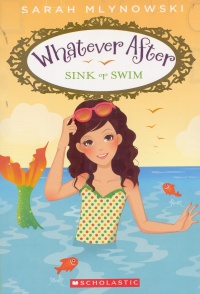| ________________
CM . . .
. Volume XX Number 35. . . .May 9, 2014
excerpt:
Abby, age 10, and her fun-loving brother Jonah, age seven, have been sucked through the magic mirror in their house and into another fairy tale. This time, it’s Hans Christian Andersen’s “The Little Mermaid,” and Abby is determined to break her own rules and change the story because, unlike Jonah, she knows that the real story doesn’t have a happy ending. Abby’s problems, however, include a fear of water, which makes finding the Little Mermaid difficult, a royal family who insist that there is no such thing as a mermaid, a brother who would rather play in the palace than help her, and a mermaid named Lana who is so sure that she loves the prince and things will work out that she sacrifices her tail and tongue for legs. Abby has to balance the need to venture into the ocean (her fear and her brother’s enthusiasm) with water safety, avoid cranky palace servants, get help from the friendly cook (whose great-great-grandmother talked with a mermaid), oh, and save Lana from dying when the prince turns out to be more concerned with appearances than with character or communication. And this means venturing into the ocean and negotiating with the sea witch who just happens to hate Lana’s royal father. The most fascinating addition this story adds to the Little Mermaid tale is the love of literacy developed by Lana. Since paper dissolves and ink diffuses underwater, mermaids and other ocean denizens are illiterate. After Lana loses her voice, she learns to read and write so that she and her prince can communicate. This, fortunately, leads to the discovery that the prince isn’t up to par (“What does Lana need to read and write for? She’s a princess. She just needs to smile, dance, and be beautiful”) – in fact, he’s revoltingly shallow. Abby initially argues that Lana should stay in the ocean and learn to be happy with what she has, but she comes to see that Lana’s actions took an immense amount of courage. Ultimately choosing to stay on land, Lana calls writing her “second voice” and decides to write books about the underwater world ruled by her father and sisters with whom she is reunited. The “romance” between the 15-year-old little mermaid and the beach-boy prince is entirely exasperating to Abby whose reactions are both understandable and amusing. Lana insists that she loves the prince, despite never having talked with him. The prince is entirely focused on her good looks – and then on the appalling fact that she has a tail. He doesn’t develop as a character; but then, the story isn’t about him. The pacing is quick, and the adventure takes place over approximately four days. As Lana grows beyond her infatuation, Jonah becomes (minimally) more dependable, and Abby sets aside her frustration with Lana, Jonah, and the prince to work towards an ending that doesn’t involve somebody dying. The prince and most of the humans remain extremely flat characters, and most of the water-dwelling characters come in only in the last thirty-five pages, which isn’t much space for development. The romance between the sea witch and the Sea King feels a little contrived, although their backstory functions well to explain the witch’s latent hostility toward the royal mermaid family and allows Lana a happy ending. Abby’s voice, her relationship with Jonah, and the overall tone of the story fit neatly into the “Whatever After” series and leave readers curious as to how the next fairy tale will be changed. Recommended. Janet Eastwood is a student in the Master of Children’s Literature program at the University of British Columbia.
To comment
on this title or this review, send mail to cm@umanitoba.ca.
Copyright © the Manitoba Library Association. Reproduction for personal
use is permitted only if this copyright notice is maintained. Any
other reproduction is prohibited without permission.
NEXT REVIEW |
TABLE OF CONTENTS FOR THIS ISSUE
- May 9, 2014.
AUTHORS |
TITLES |
MEDIA REVIEWS |
PROFILES |
BACK ISSUES |
SEARCH |
CMARCHIVE |
HOME |
